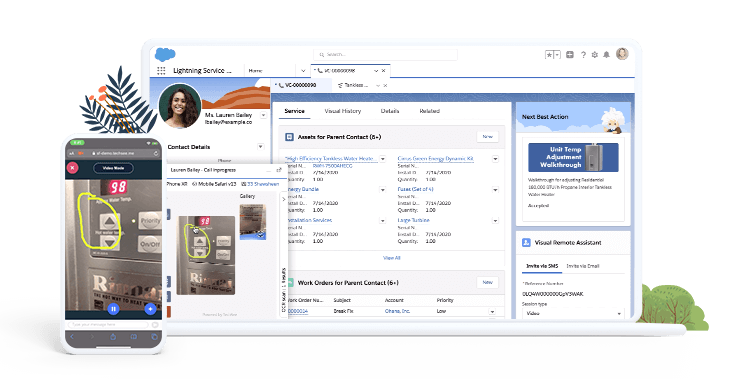Salesforce Service Cloud Voice is now available in many European countries. With this new service, Salesforce integrates its CRM solution into telephone customer service systems. Two silos that used to work side by side are now combined to provide a better customer experience.
We spoke to Salesforce a couple of times before about innovations for the customer service market. The company has been experimenting with the technology for some time. This has resulted in a new product, now available in Europe. This product immediately takes the customer experience to a higher level.
Salesforce and Amazon join hands
For the first version of Service Cloud Voice, Salesforce has found a reliable partner in Amazon Web Services. With Cloud Voice, Salesforce offers a combined solution. It is a Salesforce extension to the Service Cloud platform combined with Amazon Connect, a cloud-based telephony service.
Amazon Connect is a simplistic but high-quality telephony service. All an employee needs to have to make phone calls with this service is a laptop, an internet connection and a headset. Amazon Connect works entirely over the internet and with any modern web browser. It’s just a matter of logging into a web portal, and Amazon Connect is good to go. In the case of Service Cloud Voice, you can log in to Salesforce and use its telephony service there.
Speech-to-Text
With Service Cloud Voice Salesforce has built a complete solution around Amazon Connect. When using the service, telephone calls are directly linked to an AWS Speech-to-Text service. This leads to the calls also being written out within the Salesforce application.
Because the conversation is available in text, real-time analyses can be carried out. The text can be analysed for sentiment: how friendly or unhappy is the customer? The software can also understand a customer’s question and directly search for an answer in a knowledge base. This answer is then shown to the service employee. As a result, the customer can be helped faster. Based on real-time analysis, a flow can also be started. For example, a diagnosis of the customer’s equipment can start automatically, so that the results of this diagnosis are available more quickly during the call. This will lead to a significant increase in the speed at which customer service calls are handled, which in turn leads to higher customer satisfaction.
Related: The future of customer service and experience
Analyses bases on hundreds or thousands of conversations
Having a conversation available in text opens new doors for analyses, both in real-time and after the conversation. With Salesforce Service Cloud Voice, conversations can also be stored in a way that analyses can be performed with machine learning and AI solutions.
Companies can obtain very useful information and analyses based on the many conversations that are held. Here are a few examples:
- Which products are the most questions about?
- Which problems are the most common and in which region is this the case?
- With which competitors is the company compared?
- Which competing products are mentioned the most?
- What do customers have to say about the quality of the products?
- How often does a customer support employee have an unpleasant conversation with a customer? Is any additional training needed?
- Which conversations take the longest time, and is there a pattern in the subject of these conversations?
These are just a few examples of reports that can be based on text analysis. On the one hand, this can help to improve the products, but on the other hand, it can help solve common questions and problems more quickly. This, in turn, reduces customer service costs.

Right now, many companies still depend on notes made by their customer service staff. This takes a lot of time. The staff members need to write down their notes after every call. Salesforce has now automated this process. The software also helps supervisors and call centre managers with their jobs. They can indicate what is important to them in Service Cloud Voice, and through AI and machine learning, the software can mark calls that the manager needs to look into. This is much more effective for assessing whether an employee is good at his or her job than just random sampling.
Speech only in English for now
Service Cloud Voice can also speak to the customer using Natural Language Processing. This is currently only available in English. For this purpose, Salesforce employs the Amazon Lex Bot. The Lex Bot converts written text into natural speech, a so-called Text-to-Speech service. In the future, the Lex Bot will undoubtedly support more languages, and then Salesforce will also support them.
Companies that offer their services in English can already use it. Lex Bot can handle simple questions fully automatically. Whether it fits your use case, depends on the type of company and on policies you run. For simple questions, the system could be fully automated. As a result, customer service employees only have to deal with more difficult topics.
The (almost) complete replacement of employees will not happen soon. Companies would rather choose a hybrid approach, as they now do with the so-called IVR system (Interactive Voice Response). This is the system where you go through a couple of menus by selecting numbers on your phone. These menus are often annoying for the customer, but enable companies to perform analyses on the type of calls that come in. Number recognition is also used for this purpose, and the option to type in or say your postal code is an option as well these days.
With Speech-to-Text and Text-to-Speech, however, this whole process can become much more intelligent. Conversations become shorter and more efficient and everyone is happier. The customer is served faster, the company has lower costs, and the service is better all-round.
Service Cloud Voice will receive some extensions
Salesforce reports that, although this is a new product, some extensions are still in the works. As a result, Service Cloud Voice could become interesting to more potential customers. Of course, Salesforce hopes that Amazon will soon support more languages, enabling more analyses to be done and more possibilities to make use of a bot for automated communication.
The first major update will come this winter. Salesforce is planning to add an open API to Service Cloud, which can be integrated by other telephone companies. The company is aiming for many existing telephony solutions to work with Service Cloud Voice. Chances are that more traditional telephony services such as Cisco and Genesys will then support it.
Traditional telephony solutions welcome as well
However, these services will have to work well to meet the requirements, as the telephony partner will also have to take care of real-time transcription to text. These parties could, in turn, set up their own cloud service, based on Amazon or some other major cloud provider. In any case, they would need to be able to offer it.
Salesforce makes it very clear that although Amazon Connect is very suitable for the job, it certainly isn’t an exclusive collaboration. However, traditional players are now forced to innovate, as Amazon Connect is known for its simplicity. The system can be up and running within 20 minutes. With traditional telephony services, you really need a partner to implement it, because the services are often still too complex.
Video calling vs Visual Remote Assistant
Another innovation that we have briefly discussed with Salesforce, but which does not appear to be on Amazon’s roadmap yet, is video calls. We can imagine that video calls can also make communication with a customer service department more efficient. It won’t help much with a simple invoice problem, but in the event of breakdowns and defects, an employee can see the problem for themselves. In many cases, this can lead to faster solutions.
Salesforce says they have a similar feature called Visual Remote Assistant. It sends an e-mail or text message to the customer containing a URL. When the customer opens this link, a one-way video connection is set up where the employee can see through the customer’s camera. This is an effective way to use video in certain cases.

There is currently no solution for real video calls, where both parties are on camera. There isn’t a company yet that has developed a telephony solution with a customer service approach that supports video calling. Amazon Connect doesn’t support it either. Amazon does have its own video communication service called Chime. So it should only be a matter of bringing two existing AWS technologies together in one solution. It is certainly not impossible. For Salesforce, the remote assistance addition is sufficient at the moment.
For now, Salesforce is focused on actually selling and rolling out Service Cloud Voice. Salesforce Service Cloud Voice is certainly a solution the company has high expectations of and where there are still plenty of opportunities to expand, starting with broader language support. Salesforce is not revealing much of their roadmap, but in the coming years, this service will receive several updates. That much is clear.


















